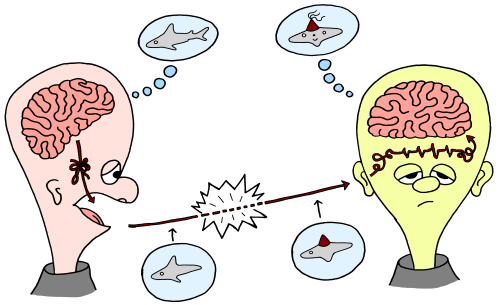This is a video of the talk that I did in Cluj, Romania. It was…
It’s Only Communication When There’s Verification
One-way messages don’t count as “communication.” The traditional way of thinking of communication as “the transmission of information from one person to another” is wrong, wrote Alistair Cockburn in Agile Software Development.
To explain this, let us review what actually happens when you intend to “communicate” something to me. Your intention results in a translation of what you actually mean, according to your own internal model of the world, to some physical actions on your part, like speaking words, modulating pitch, speed, and volume, gesturing with your hands, moving your facial muscles, typing text into a device, or writing something on a piece of paper. This first part of our communication already has plenty of opportunity to invite problems to creep in, because your translation from thoughts to actions may be erratic, like confusing left with right (as I usually do). Or you may employ context- and culture-dependent assumptions, like nodding your head means “yes,” and shaking it means “no,” which is an assumption that will fail in various parts of the world.
Subsequently, your erroneous or ambiguous signals then traverse some medium, like the air, a computer network, or the post office. This means that noise and faulty mechanisms in the medium may further distort your message before it arrives at my sensory inputs (particularly when the medium at some point involves my own wireless network at home).
Finally, the unreliable signals arrive at my eyes and ears, which may not work fully as expected because of the weird stuff I drank yesterday night. The part that gets through is then processed using pattern-matching, and I arrive at a conclusion of what you are trying to say to me. But the words you speak, or the way you move your face and hands, might be unfamiliar to me. And even when the information gets through correctly, I might still associate your signals with other meanings because the internal reference models I have in my head could be very different from yours. You keep talking about Scrum, and in my mind I see sixteen big dirty men wrestling over a ball in the grass…
So you see, there are so many things that can go wrong on the way from your brain to mine that it is almost guaranteed that your meaning of what you sent is not the same as the meaning that I attach to what I received. This, as Cockburn indicates, is not communication. This is miscommunication, and it often leads to confusion and conflict. Because, as motivational speaker Ian Percy said, “We judge others by their [perceived] behavior. We judge ourselves by our intentions.” And there is a world of difference between what we intend and what is perceived.
Real communication includes making sure that the meaning that is assigned to a message is the same on both sides. Technical communication protocols (like the Internet’s TCP/IP model and the HTTP protocol) contain various techniques for (trying to) make sure that what gets sent by one system is properly received by the other. With human communication we have the same requirement. It is only really communication when both parties have verified that they have properly exchanged information and that both are assigning the same meaning to it.
(image by jimmybrown)
This article will be part of the book Management 3.0: Leading Agile Developers, Developing Agile Leaders. You can follow its progress here.
 Twitter –
Twitter –  Subscribe –
Subscribe –  Newsletter –
Newsletter –  LinkedIn –
LinkedIn –  SlideShare
SlideShare
| Latest, greatest and favoritest posts: 7 Approaches to Competence Development Managers Are Not Game Designers! Commit to Sprint Planning or Definition of Done, Not Both |






